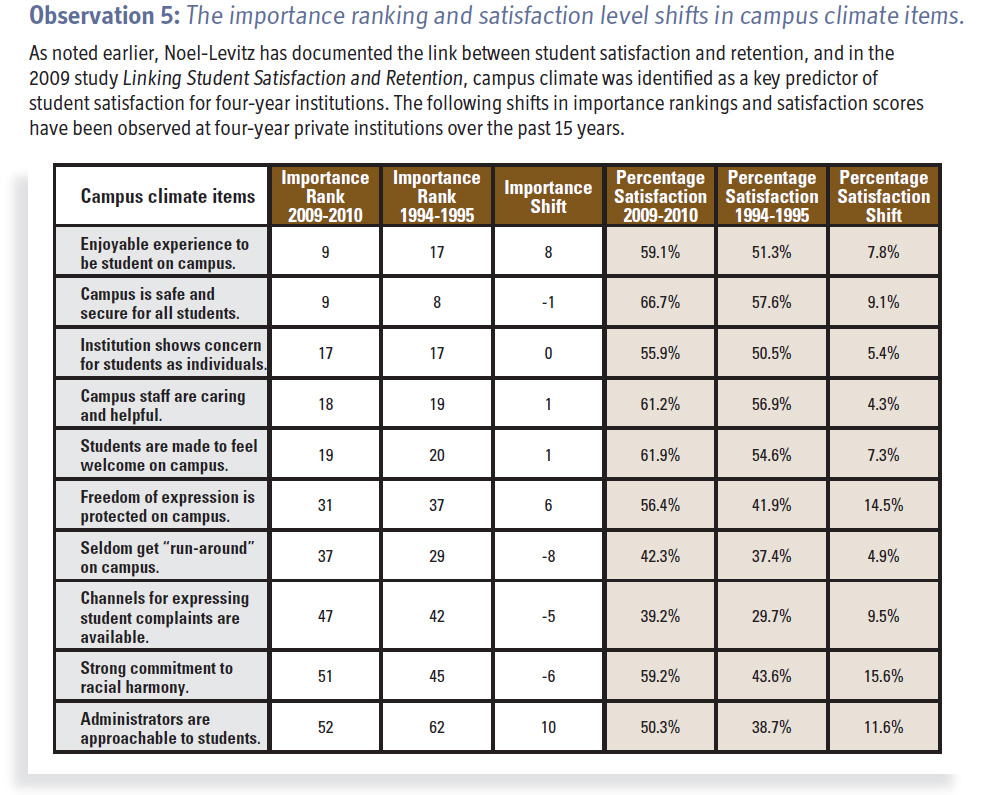student success
The quality of your life is the quality of your communications
The best things in life are free. The simplest things often have the biggest impact on life. These are common expressions, but they also speak to how we can create a more positive, more satisfying environment for college students.
The table below from the 2011 Noel-Levitz National Student Satisfaction and Priorities 15-Year Trend Report, four-year private segment, highlights items measuring campus climate. It is interesting that a variety of measures focus on communication and interactions on campus. These simple things have a profound impact on student satisfaction and retention.

Note: While, this table is from the four-year private report, other institution types reported similar results; information for four-year public campuses, two-year public institutions, and career and private schools are available online.
Simple steps to improve interactions between campus personnel and college students
So how can you improve these important aspects of campus life? There are a number of simple steps you can take to improve student communication and satisfaction.
Make it a habit—Make a note card of the title of this blog and put it where you will see it every day. Embrace it. Action begins with awareness before it can rise to priority.
Let’s be equals—Staff members have an upper hand over students on campus, in both status and control. So let’s go out of our way to make students feel important, every time, by:
- Engaging with eye contact
- Pausing to pay full attention during every interaction
- Smiling; you can smile with your eyes, even during serious business
- Listening thoughtfully before responding
Smile with your voice—The quality of your voice adds immeasurably to the quality of your communication. Strive for a friendly tone. Remember, it is impossible to not have a friendly tone if you are smiling, even slightly.
Verbalize names—Use the name of the person you are communicating with; use first name, if appropriate, or last name with Dr., Mr., Mrs., or Ms.
Use “I” messages—“You” messages can lean toward the confrontational, while “I” messages tend toward the opposite. Role-play using “I” messages in your work unit as a fun teambuilding activity. Three-part “I” messages are best. Constructing I-messages involves three simple steps:
- Describe the behavior that is interfering with you (just describe, don’t blame)
- State your feelings about the consequences the behavior produces for you
- State the consequences
Avoid selective listening—Do not allow your communications to be compromised by:
- Interrupting
- Rushing to conclusions
- Allowing status, attire, or mannerisms to become distractors
- Missing body language clues
Avoid common roadblocks to effective communication—Don’t allow yourself to:
- Make assumptions about what the speaker needs or is about to say
- Become distracted and appear unfocused or unconcerned
- Spend too much time thinking about the ‘comeback’ response
All of these are strategies I cover when I conduct Connections quality service training on campuses. I have seen these strategies not only transform interactions between students and campus personnel, but also communications among campus colleagues.
As we begin 2012, here’s to enjoying the certain benefits of using this sampling of reminders about improving communication. If you have any questions or would like to share your own communication strategies, please leave a comment or send me an e-mail.